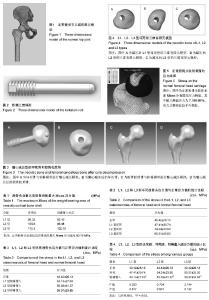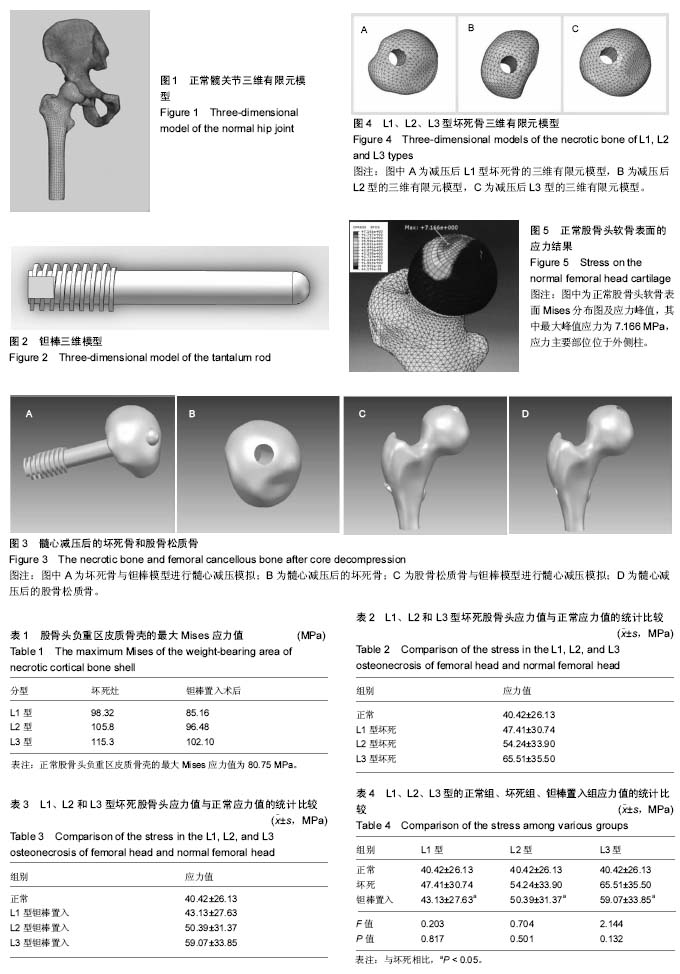| [1] 李子荣. 股骨头坏死: 早期诊断与个体化治疗[J]. 中国矫形外科杂志, 2013, 21(19): 1909-1911.[2] 何伟.如何把握股骨头坏死患者的保髋治疗时机[J]. 中国骨与关节杂志, 2016, 5(2): 82-86.[3] 李子荣, 刘朝晖, 孙伟, 等. 基于三柱结构的股骨头坏死分型: 中日友好医院分型.全国骨关节与风湿病暨第三届武汉国际骨科高峰论坛论文汇编[C]. 2012-09-07:13-22.[4] 中华医学会骨科学分会关节外科学组. 股骨头坏死临床诊疗规范[J]. 中国矫形外科杂志, 2016, 24(1):49-54.[5] 庞智晖, 魏秋实, 周广全, 等. 个体股骨头坏死三维有限元模型的建立与应用[J]. 生物医学工程学杂志, 2012, 29(2):251-255.[6] Tsao AK, Roberson JR, Christie MJ, et al. Biomechanical and clinical evaluations of a porous tantalum implant for the treatment of early-stage osteonecrosis. J Bone Joint Surg Am. 2005;87(2):22-27.[7] 凌观汉, 欧志学, 姚兰, 等. 中日友好医院分型的L型股骨头坏死仿真三维模型建立[J].中国组织工程研究, 2017, 21(7): 1074-1079.[8] Brown TD, Way ME, Ferguson AB Jr. Mechanical characteristics of bone in femoral capital aseptic necrosis. Clin Orthop Relat Res. 1981;156:240-247.[9] Brown TD, Hild GL. Pre-collapse stress redistributions in femoral head osteonecrosis--a three-dimensional finite element analysis. J Biomech Eng. 1983;105(2):171-176.[10] Stewart KJ, Edonds-Wilson RH, Brand RA, et al. Spatial distribution of hip capsule structural and material properties. J Biomech. 2002;35(11):1491-1498.[11] Grecu D, Pucalev I, Negru M, et al. Numerical simulations of the 3D virtual model of the human hip joint, using finite element method. Rom J Morphol Embryol. 2010;51(1): 151-155.[12] von Eisenhart R, Adam C, Steinlechner M, et al. Quantitative determination of joint incongruity and pressure distribution during simulated gait and cartilage thickness in the human hip joint. J Orthop Res. 1999;17(4):532-539. [13] Abraham CL, Maas SA, Weiss JA, et al. A new discrete element analysis method for predicting hip joint contact stresses. J Biomech. 2013;46(6):1121-1127.[14] 杨彬, 何伟, 魏秋实, 等. 高仿真股骨头坏死的数字化表达[J]. 中华关节外科杂志(电子版), 2012, 6(4):588-595.[15] Tanzer M, Bobyn JD, Krygier JJ, et al. Histopathologic retrieval analysis of clinically failed porous tantalum osteonecrosis implants. J Bone Joint Surg Am. 2008;90(6): 1282-1289. [16] OH KJ, Pandher DS. A new mode of clinical failure of porous tantalum rod. lndian J Orthop. 2010;44(4):464-467.[17] Shi J, Chen J, Wu J,et al. Evaluation of the 3D finite element method using a tantalum rod for osteonecrosis of the femoral head. Med Sci Monit. 2014;20(4):2556-2564.[18] Liu WG, Wang SJ, Yin QF, et al. Biomechanical supporting effect of tantalum rods for the femoral head with various sized lesions: a finite-element analysis. Chin Med J. 2012;125(22): 4061-4065.[19] 张怡元,冯尔宥,陈日齐,等. 多孔钽块置入治疗股骨头缺血性坏死的生物力学及三维有限元分析[J]. 中国矫形外科杂志, 2012, 20(12): 1113-1116. |

